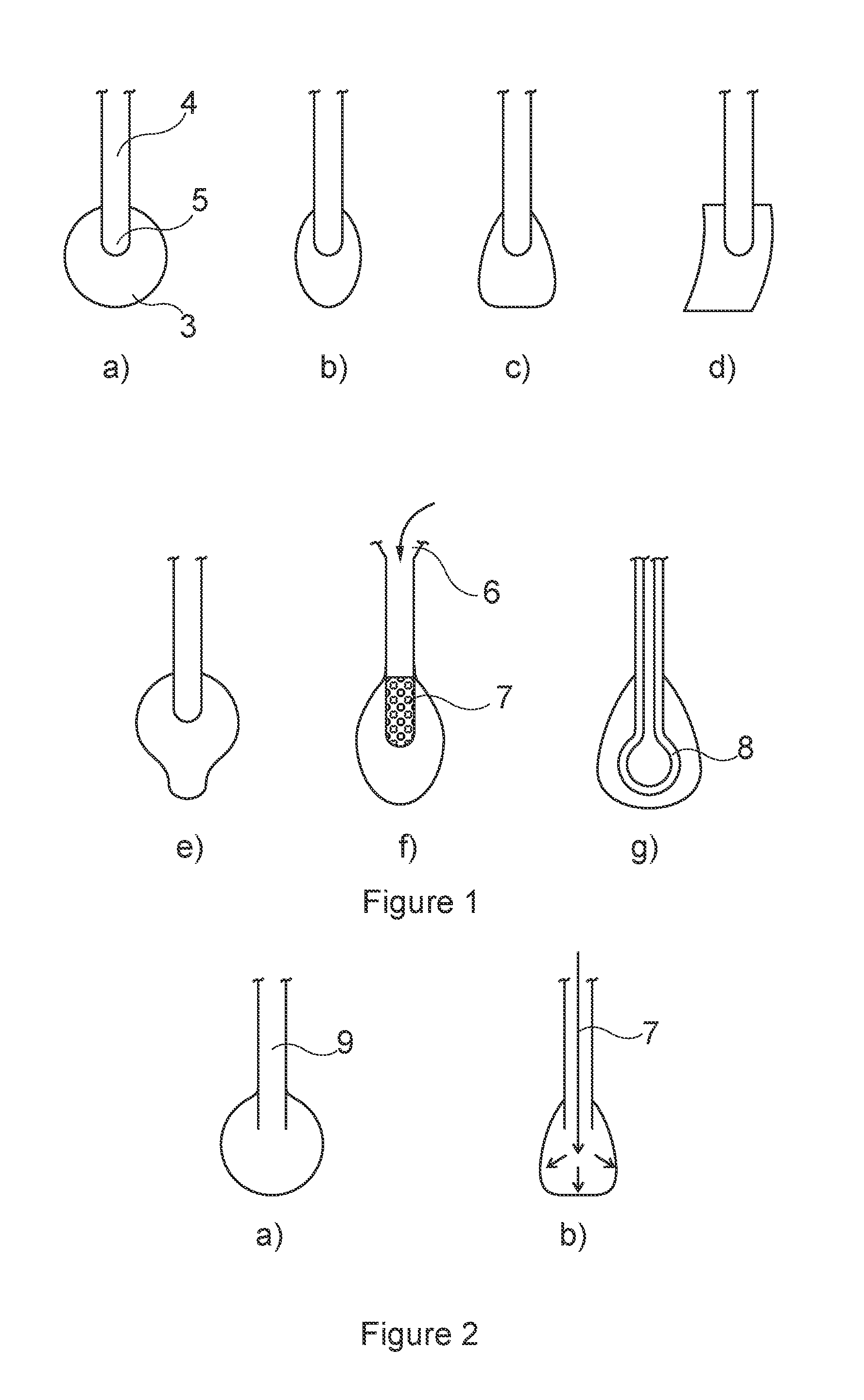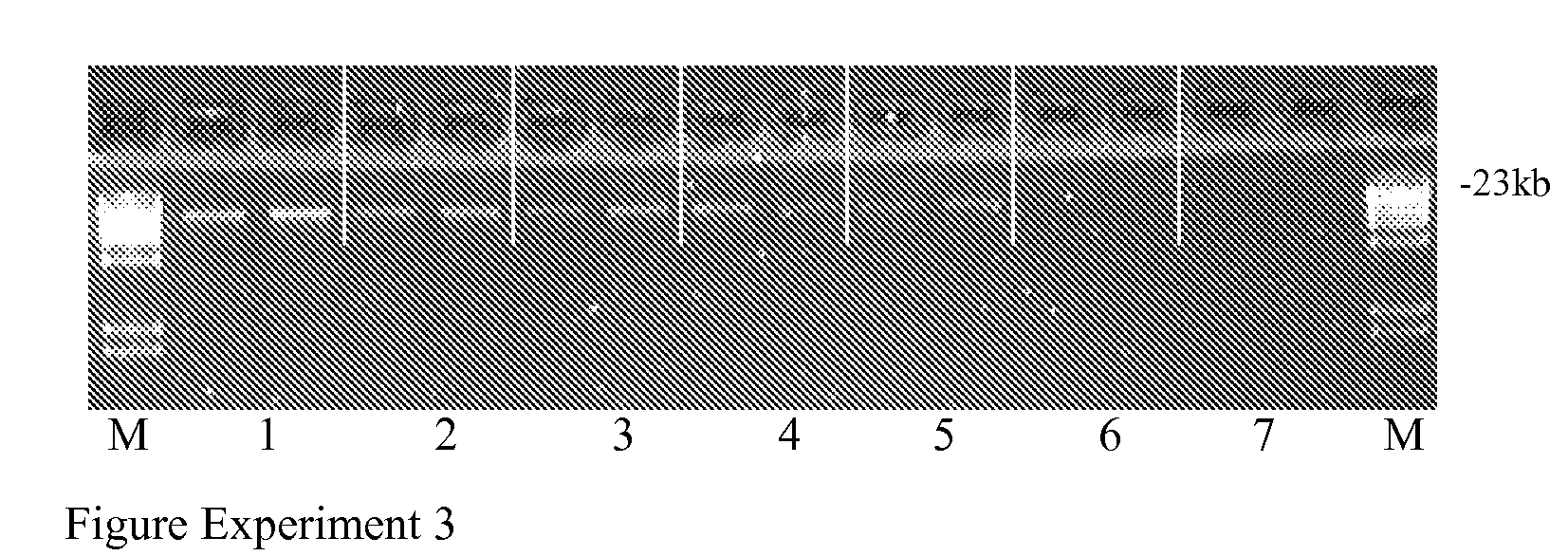Method and materials for triggered release of a biological sample
a biological sample and triggered release technology, applied in the field of triggered release of biological samples, can solve the problems of cross-contamination, inefficiency, general inefficiency,
- Summary
- Abstract
- Description
- Claims
- Application Information
AI Technical Summary
Benefits of technology
Problems solved by technology
Method used
Image
Examples
example 1
Extraction of DNA from a Soluble Buccal Swab Using a Chaotropic Solution
[0096]Cellulose acetate fibers in the form of a swab were used for taking buccal swabs from human donors. Swabs were cut into two equally sized pieces (A and B) and DNA was extracted using different procedures.
Procedure 1
[0097]Cellulose acetate swab part A was dissolved in 800 μl of Buffer AVL (high salt buffer from QIAGEN containing guanidinium salt) over five minutes at room temperature with gentle agitation. 560 μl of the suspension were transferred into a 2 ml microcentrifuge tube and 560 μl of ethanol added to the tube containing the suspension. Mixing was carried out by vortexing and the sample was transferred onto a column with a membrane (QIAamp Mini Spin column from QIAGEN). The column was centrifuged at 8,000 rpm for one minute to bind nucleic acids to the membrane. The column was washed a first time with 500 μl of AW1 buffer (guanidinium salt and ethanol containing buffer from QIAGEN), followed by cen...
example 2
Solubility of Cellulose Acetate Phthalate in Different Buffers
[0101]The solubility of cellulose acetate phthalate (CAP) in different buffers was investigated.
[0102]50 mg (+ / −1 mg) of CAP were transferred into a 2 ml microcentrifugation tube. 1 ml buffer was added. The tube was closed and subjected to pulse vortexing for 10 seconds to mix the contents. The tube was then observed at room temperature for 30 hours.
[0103]The buffers used were ATL (a lysis buffer for bacteria), AVL (a lysis buffer), MTL (a lysis and binding buffer), ML (a lysis and binding buffer), and RLT (a lysis buffer), all of which are commercially available buffers from QIAGEN.
[0104]The results are given in the following table 1.
TABLE 1Buffer30 min1 h3 h10 h24 h30 hATLCAPNotNotOnly fewCAPCAPbeadsswollen,swollen,smallbeadsbeadsunaffectedlittlesignificantlybeadstotallytotallydissolveddissolvedvisibledissolveddissolvedAVLCAPSignificantlyNearlyCAPCAPCAPbeadsdissolvedtotallybeadsbeadsbeadsstickdissolvedtotallytotallytota...
example 3
Extraction of DNA from a Meltable Swab Using a Chaotropic Solution
[0105]Swabs with a head made of Paraffin (Paraplast-XTRA, melting point 52° C., McCormick Scientific) were used for taking samples from HeLa cells. Swabs were melted at 70° C. in different solutions with or without chaotropic salts. DNA was extracted using the QIAamp DNA (QIAGEN) procedure.
Procedure
[0106]HeLa cells grown as monolayer were washed twice with PBS. Cells samples were taken with swabs with a head made of Paraplast-XTRA shaped as a scraper. The head of the swabs were dissolved in a 2 ml microcentrifuge tube within 500 μl of different reagents with or without a chaotropic salt (Tab. 2, reagent composition). Melting of the swab head was achieved by incubation for 10 min at 72° C. with gentle agitation. After centrifugation at full speed for 1 min (14,000 rpm) the paraplast constituted a solid layer on top of the liquid solution. 400 μl of the liquid solution were retrieved and transferred into a new 2 ml micr...
PUM
| Property | Measurement | Unit |
|---|---|---|
| temperatures | aaaaa | aaaaa |
| temperatures | aaaaa | aaaaa |
| temperatures | aaaaa | aaaaa |
Abstract
Description
Claims
Application Information
 Login to View More
Login to View More - R&D
- Intellectual Property
- Life Sciences
- Materials
- Tech Scout
- Unparalleled Data Quality
- Higher Quality Content
- 60% Fewer Hallucinations
Browse by: Latest US Patents, China's latest patents, Technical Efficacy Thesaurus, Application Domain, Technology Topic, Popular Technical Reports.
© 2025 PatSnap. All rights reserved.Legal|Privacy policy|Modern Slavery Act Transparency Statement|Sitemap|About US| Contact US: help@patsnap.com



